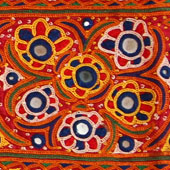.
Rabari Embroidery - Bhujodi
Rabari embroidery gets its name from its community from Bhujodi, who were a nomadic/ semi nomadic community of cattle raiser living in the western region of India, from Rajasthan to the Kutch region in Gujarat.
Earlier, the term Rabari was loosely applied to migratory camel herders having similar customs and beliefs due to their profession and different sub communities of Rabari’s. Each community and culturally linked group in Gujarat is distinctively identified by the kind of embroidered costuming, body tattoos and living settlements. The white dress is commonly wore by all Rabari men but black wool clothes, is worn only by the minority population of bharvad shepherds in the east of the region, relates to rule made by Chach, a Hindu ruler who conquered in the 8th century. [1]
Mirror chain stitch in various size and shapes is the specialty of Rabari embroidery, given this style a unique and beautiful edge compared to various other types in the league. Women use their creativity, aesthetics in embroidery works on textiles.
All girls in the community involve in embroidery work of Kanchali (backless blouses), Paheranu (wrapped skirts), a ghagharo (stitched skirt), and ludi (woolen veil). The girls prepare their own bridal dress, Toran (doorway hanging), shawl, bags, bedcovers and decorative camel covers for her future husband and family. All the girls have to learn the art of embroidery for the collectives for the dowry. This tradition has been passed on to the daughters through generations.
Reference:
[1] FRATER, JUDY, (1995) Threads of identity, Reprinted and published by Mapin Publishing Pvt. Ltd, Ahmedabad 2003.









